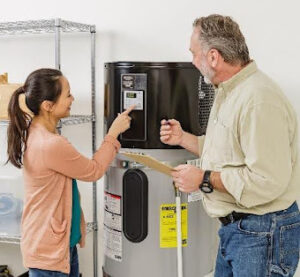May 31, 2024
Topic
Heat pump water heaters (HPWH) offer significant energy savings compared to traditional water heaters, and can help meet California’s goals to combat climate change and reduce greenhouse gas emissions. So, can local government jurisdictions support the adoption of this highly efficient technology? TECH Clean California is trying to help jurisdictions do just that!
TECH Clean California already offers incentives for eligible customers pursuing HPWH projects and recently completed a Permitting and Installation of Heat Pump Water Heaters Final Pilot Report. In partnership with the Bay Area Regional Energy Network (BayREN), the pilot aimed to support California building departments by building awareness and providing resources and support to achieve simple, streamlined and one-day permit approvals for HPWH. The pilot found that additional resources for building departments can support permitting and provided resources and recommendations for building departments to leverage.
What is a heat pump water heater?
Heat pump water heaters are a game-changer in the realm of residential and commercial water heating. Unlike conventional water heaters that rely on fossil fuels or electricity generated from non-renewable sources, HPWHs utilize heat transfer technology, making them significantly more energy efficient. By extracting heat from the surrounding air and transferring it to the water tank, these systems can deliver hot water with remarkable efficiency, reducing energy consumption and utility bills while lowering carbon emissions.
 In California, where stringent environmental regulations and ambitious climate goals are driving the transition to clean energy, HPWHs offer a compelling solution to reduce the state’s carbon footprint. According to the California Energy Commission (CEC), residential water heating accounts for approximately 18% of the State’s total residential energy consumption. By promoting the adoption of HPWHs, California can make significant strides towards achieving its energy efficiency and climate objectives outlined in the landmark SB 350 legislation, which aims to double the energy efficiency savings in electricity and natural gas end uses by 2030.
In California, where stringent environmental regulations and ambitious climate goals are driving the transition to clean energy, HPWHs offer a compelling solution to reduce the state’s carbon footprint. According to the California Energy Commission (CEC), residential water heating accounts for approximately 18% of the State’s total residential energy consumption. By promoting the adoption of HPWHs, California can make significant strides towards achieving its energy efficiency and climate objectives outlined in the landmark SB 350 legislation, which aims to double the energy efficiency savings in electricity and natural gas end uses by 2030.
Streamlining Permitting for HPWHs
TECH Clean California wanted to understand if the permitting and installation process poses a significant hurdle to their widespread adoption.
The pilot team performed a quantitative permit data analysis on projects that applied for a TECH Clean California HPWH incentive between December 2021 through February 2023. The pilot team determined that the statewide average time to heat pump water heater permit issuance is 5.9 days, significantly longer than a standard water heater permit.
The pilot also performed qualitative interviews with select building jurisdictions. The interview led to pilot findings including:
- Lack of personal knowledge around HPWH leads to more errors in the contractor process.
- Written resources are not sufficient on their own to educate building department staff on HPWH permitting.
- Understanding barriers contractors face is important to streamlining heat pump water heater permitting.
- There is no standardized process across the state for HPWH permitting.
HPWH Resources for Local Governments
In effort to streamline HPWH permitting processes, the pilot created the written resources to assist building department staff and permit applicants:
-
- HPWH Permit Supplement Template
- Electrical Load Estimator
- 2022 HPWH Building Code Assistance Sheet
These resources are available for local building departments to download and share with installers and the public.
If you are interested in learning more about the TECH Clean California program or the Streamlining Permitting and Installation of Heat Pump Water Heaters, please contact Nancy Barba, Frontier Energy, on behalf of TECH Clean California.




